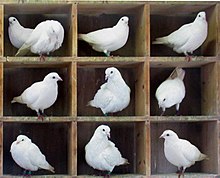 In mathematics, the pigeonhole principle states that if n items are put into m containers, with n > m, then at least one container must contain more than one item. Here there are n = 10 pigeons in m = 9 holes. Since 10 is greater than 9, the pigeonhole principle says that at least one hole has more than one pigeon.
In mathematics, the pigeonhole principle states that if n items are put into m containers, with n > m, then at least one container must contain more than one item. Here there are n = 10 pigeons in m = 9 holes. Since 10 is greater than 9, the pigeonhole principle says that at least one hole has more than one pigeon.
Using the pigeon hole principle, try to solve the following problems:
A road is 30 meters long, and you try to plant 34 flags alongside the road. Now prove that no matter how you plant the flags, at least 2 flags has a distance between them that is less than 1 meter.
Divide 54 apples among 10 people. Can we divide it in a way so that every person has apple(s), and has different numbers of apples? Why?
In a bucket, there are 4 colors of balls: red, green, white, and yellow. At least how many balls should we pick from the bucket, so that:
1. At least 3 balls have the same color?
2. At least 5 balls have the same color?
3. At least 8 balls have the same color?